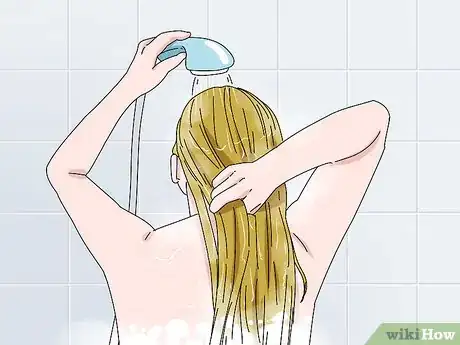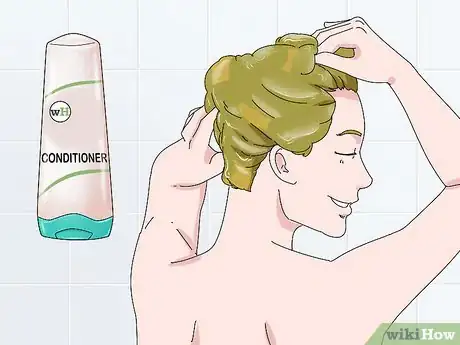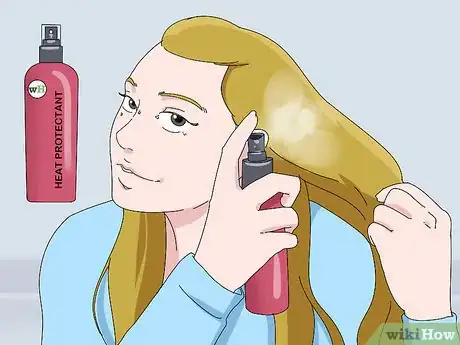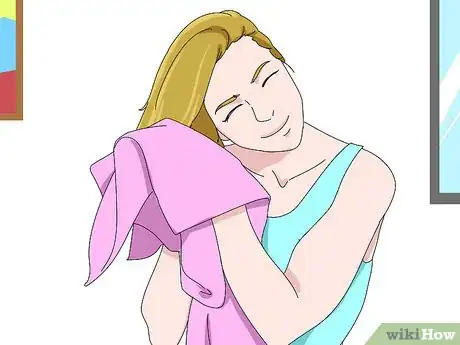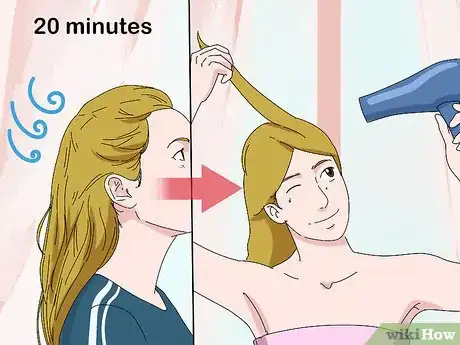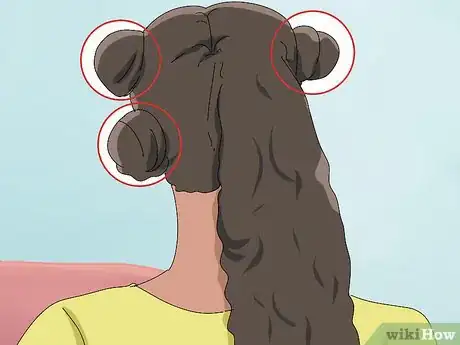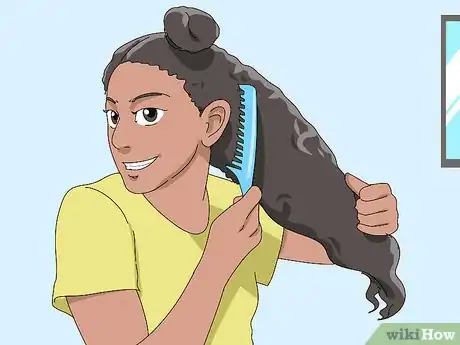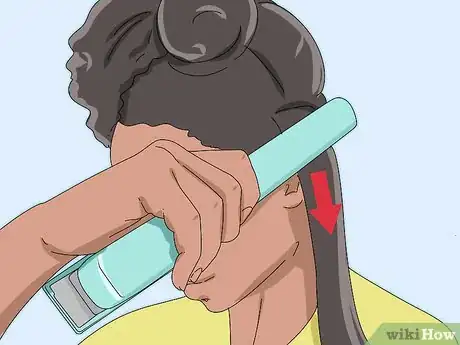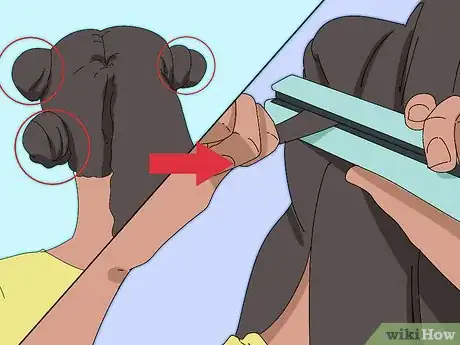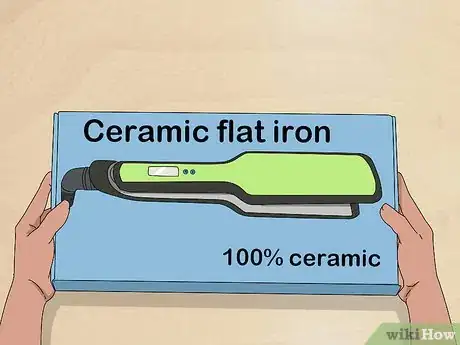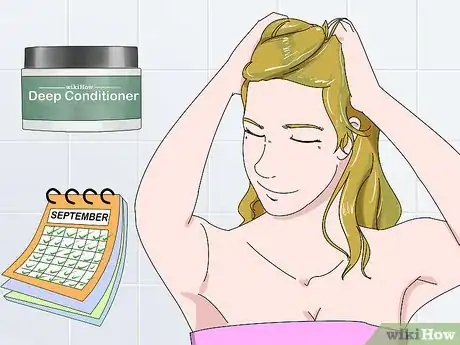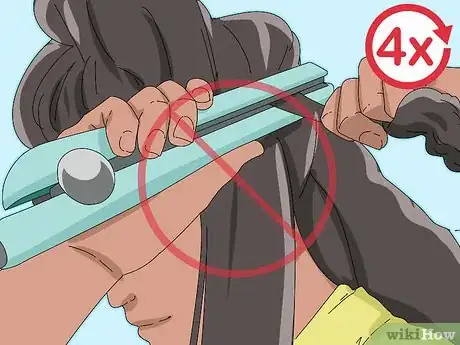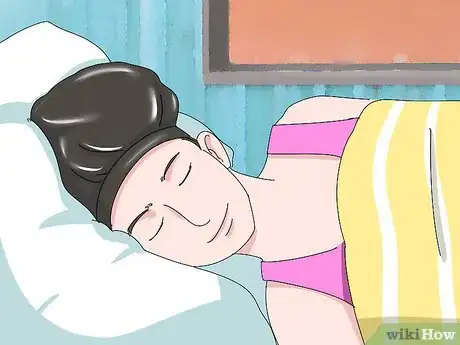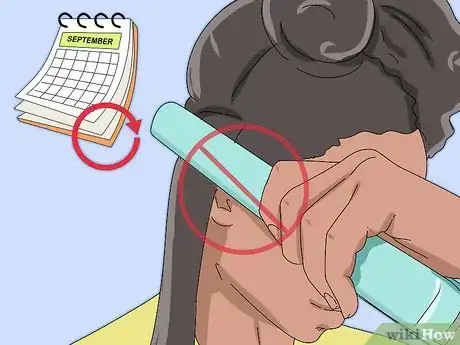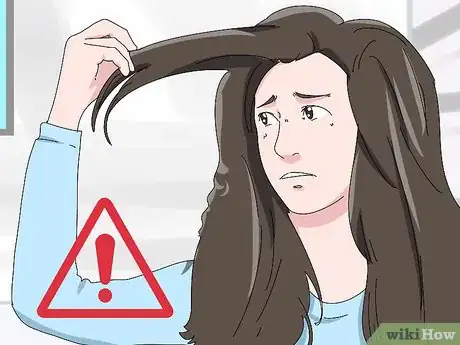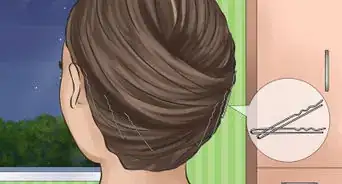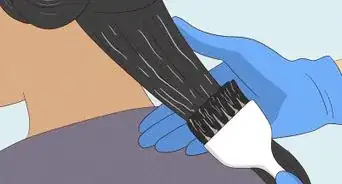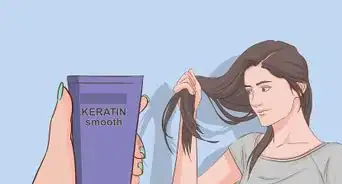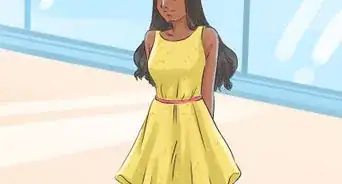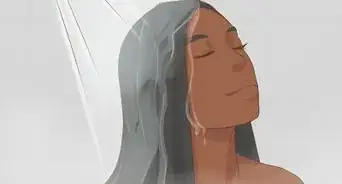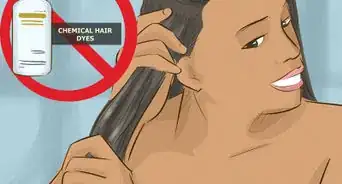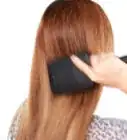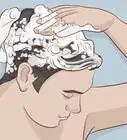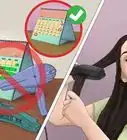This article was co-authored by Michael Van den Abbeel. Michael Van den Abbeel is a Professional Hair Stylist and the Owner of Mosaic Hair Studio and Blowout Bar in Orlando, Florida. He has been cutting, styling, and coloring hair for over 17 years. Michael loves showing his clients how to wash and wear their hair easily and effortlessly. Mosaic Hair Studio and Blowout Bar is recognized as a Diamond Top Tier level Wella salon.
There are 12 references cited in this article, which can be found at the bottom of the page.
This article has been viewed 27,207 times.
Flat irons can be a useful beauty tool for achieving straight or even wavy hair. This look can be a great way to mix up your style. Unfortunately, flat irons can cause severe heat damage, especially to natural hair. But if you take a few extra precautions, you can straighten your natural hair without ruining it. To minimize the risk of damage, prepare your hair for the heat with conditioning treatments and heat protectors. Then carefully apply the heat to your dry hair in sections. Finally, be sure not to overexpose your hair to flat ironing.
Steps
Preparing to Heat up Your Natural Hair
-
1Wash your hair. The best time to flat iron natural hair is right after you have washed and conditioned your locks. If you flat iron hair that contains any hair products or dirt, then your hair will likely look stiff, instead of appearing flowy.[1]
- While you can (and should) prepare your hair for flat ironing with heat protectant products, you don’t want to leave other routine hair care products (like hairspray) in your hair before you flat iron it.
-
2Condition your hair daily. Conditioner strengthens and moisturizes your hair, keeping it healthy and lush. Although using this product should be part of your daily routine, it’s especially important to condition prior to applying heat through flat ironing. On the day you plan to straighten your hair, apply and then rinse out a daily-use moisturizing conditioner when you shower.[2]Advertisement
-
3Use a heat protectant before you blow dry and flat iron. Heat protectants are a great way to mitigate the damage caused by heat. These products often contain silicon, which coats and protects the hair from the heat of the dryer and flat iron. Spray your hair twice if you’re blow drying and then following up with a straightener.[3]
- Most of these products can be applied to wet or dry hair.
-
4Let fine or thin hair air dry to minimize damage. After you’ve washed and conditioned your hair, fully dry it before you start straightening. If you have thin strands of hair prone to breakage, the texture of your hair is what’s known as “fine” or “thin.”[4] This texture is especially at risk for heat damage, so it’s best to let it air dry overnight before flat ironing.[5]
- Any moisture left in your hair will bubble up during the heating process and damage your hair further.
-
5Blow dry hair with a thicker or coarse texture. If your strands are a bit thicker and generally don’t break, you’re safe to add a little heat with the blow dryer.[6] Let your hair partially air dry for about 20 minutes before blow drying it. Then, stick to low or medium heat to fully dry it out.[7]
- If you don’t have time to let your hair air dry at all, you can blow dry it right away. However, be aware that this increases your risk of damaging your hair over time. Try to limit your use of the blow dryer as much as you can.
Straightening Your Hair
-
1Decide on a temperature based on your hair’s texture and thickness. Straightening your hair can cause damage if your iron is too hot or if you make multiple passes over the same section of hair with it. To keep your hair as healthy as possible, set your iron to a temperature that’s hot enough to straighten a section with 1-2 passes, but no hotter.
- Set your iron to about 150 °F (66 °C) if you have thin, fine hair.
- Set your flat iron to about 350 °F (177 °C) if you have thick, coarse hair.
- Set you flat iron to about 250 °F (121 °C) if your hair is thick and fine or coarse and thin.
-
2Divide your hair into sections. Before you begin using the flat iron, divide your hair into sections. Use clips to pull up the bulk of your hair, and then let down a thin layer of hair at the base of your head. As you straighten each section, let out a bit more hair from your clip.[8]
- You should not straighten a section of hair that is wider or thicker than 1 inch (2.5 cm) at a time.
- If you try to straighten a section that is too thick, it won’t straighten properly.
- You may need multiple large and small clips to hold your hair in place. You can find these online or at your local pharmacy.
-
3
-
4Start at the root of your hair and run down to the tips. In order to get the best results with your flat iron, start at the roots of your hair, press down with the flat iron, and then slowly move the flat iron down the hair to the tip. Make sure that you maintain pressure the entire time.[11]
-
5Flat iron each section until your look is complete. Depending on how thick your hair is, it may take a while to flat iron every section. Be patient and don’t try to rush the process. If you need to, take a break for 20 minutes and start up again after you’ve rested.
- Generally, it will take about a half hour to an hour to finish flat ironing. If you have a lot of hair, it could take longer.
Reducing the Likelihood of Heat Damage
-
1Choose a high-quality ceramic flat iron. When you buy a flat iron, check the label. Only purchase one that reads “100% ceramic.” While these products cost more, the ceramic coating won’t wear off over time. This coating helps protect your hair against the heat, so you definitely don’t want to buy a cheap flat iron with a coating that’ll wear out after a few uses.[12]
- Basic ceramic flat irons shouldn’t cost much more than $20-$40 USD. Professional-grade straighteners, however, can cost as much as $80-$100 USD.
-
2Deep condition your hair weekly. Purchase a deep conditioner from your local pharmacy or make your own. Deep condition at least once a week if you’re flat ironing your hair. If you can do it every 3 or 4 days, that’s even better! Heat the conditioner up by placing it in a hot water bath before applying. Then, leave the conditioner in for about 15-30 minutes under a shower cap. Finally, rinse it out in the shower.[13]
- Homemade deep conditioner recipes usually contain bananas, avocados, honey, and olive or coconut oil. These natural products will work as well as the purchased version, but they can be messy to create and store.[14]
- To make a hot water bath for your deep conditioner, boil water in a saucepan. Once the water’s boiling, remove the saucepan from the heat and place your deep conditioner in the pot. Use tongs to remove the conditioner after 5 to 10 minutes.
- To amp up your treatment, add steam! Heat up a damp towel for about 2 minutes in the microwave and place it on your head in between 2 layers of shower caps. The heat will help the conditioner really get into your hair and do its great work![15]
-
3Don’t flat iron the same section multiple times. If you rush through the straightening process and try to straighten big chunks of hair, you may need to apply the flat iron to the same section of hair multiple times to get your desired look. This increased heat exposure can damage your hair.[16]
- Make sure to take your time and complete only one pass with the flat iron over each small section of hair.
-
4Avoid going bone straight if you have very curly hair. Go for a wavy look instead by flat ironing each section once without trying to make your hair completely straight. Once you’re done, run your fingers through your hair. This will give you added volume while also causing less heat damage.[17]
- If you’d like, you can even put a product in your hair that’s designed to make waves. Usually, these serums are meant to be applied right after you finish flat ironing.
-
5Wrap your straightened hair at night to avoid morning touch-ups. Use a silk or satin wrap to keep your hair straight overnight. These materials should minimize any nighttime frizziness as well. In the morning, just take off the wrap and shake out your hair. You may even get a little natural wave -- embrace it![18]
-
6Don’t straighten natural hair more than a few times a month. Heat will slowly but surely cause your natural hair to dry out and become brittle. It can also ruin your curl pattern, making it difficult to get your curls to bounce back. The most effective way to protect your hair over the long term is to limit your hair’s exposure to heat.[19]
-
7Cut back on straightening if you see heat damage. There are lots of signs you can watch out for to keep tabs on your hair’s health. If you’re damaging your hair, you may need to adjust your styling habits. It’s possible that your hair can only handle being straightened a few times per year (rather than once or twice each month).[20] Look out for the following:
Expert Q&A
-
QuestionIs it OK to flat iron natural hair?
 Laura MartinLaura Martin is a Licensed Cosmetologist in Georgia. She has been a hair stylist since 2007 and a cosmetology teacher since 2013.
Laura MartinLaura Martin is a Licensed Cosmetologist in Georgia. She has been a hair stylist since 2007 and a cosmetology teacher since 2013.
Licensed Cosmetologist You can use a straightening iron on naturally curly or straight hair. Always apply a thermal protectant first and make sure the hair is completely dry.
You can use a straightening iron on naturally curly or straight hair. Always apply a thermal protectant first and make sure the hair is completely dry. -
QuestionWhat do you need for a silk press?
 Laura MartinLaura Martin is a Licensed Cosmetologist in Georgia. She has been a hair stylist since 2007 and a cosmetology teacher since 2013.
Laura MartinLaura Martin is a Licensed Cosmetologist in Georgia. She has been a hair stylist since 2007 and a cosmetology teacher since 2013.
Licensed Cosmetologist For a silk press, you will need a flat iron and a hair dryer. You should also use a deep conditioner, a thermal protector, and a styling serum.
For a silk press, you will need a flat iron and a hair dryer. You should also use a deep conditioner, a thermal protector, and a styling serum. -
QuestionWhat temperature should I set my flat iron to for relaxed hair?
 Laura MartinLaura Martin is a Licensed Cosmetologist in Georgia. She has been a hair stylist since 2007 and a cosmetology teacher since 2013.
Laura MartinLaura Martin is a Licensed Cosmetologist in Georgia. She has been a hair stylist since 2007 and a cosmetology teacher since 2013.
Licensed Cosmetologist Relaxed hair should already be fairly straight so the iron can be on a lower setting. Between 350 and 400 degrees Fahrenheit is best; aim for the lower end and make sure to use a thermal protector.
Relaxed hair should already be fairly straight so the iron can be on a lower setting. Between 350 and 400 degrees Fahrenheit is best; aim for the lower end and make sure to use a thermal protector.
Things You’ll Need
- Daily-use moisturizing shampoo and conditioner
- Deep conditioner (DIY or store bought)
- Saucepan and hot water
- Damp towel
- Several shower caps
- Heat protectant spray
- Blow dryer
- Ceramic flat iron
- Large and small hair clips
- Paddle brush or wide-toothed comb
- Silk or satin hair wrap
References
- ↑ https://www.liveabout.com/flat-iron-success-tips-for-black-hair-400456
- ↑ https://napturallycurly.com/how-to-straighten-transitioning-and-natural-hair/
- ↑ http://www.curlcentric.com/how-to-flat-iron-natural-hair/
- ↑ http://www.naturalhairrules.com/hair-typing-for-beginnings/
- ↑ https://www.liveabout.com/should-i-blow-dry-my-hair-before-i-flat-iron-it-400055
- ↑ http://www.naturalhairrules.com/hair-typing-for-beginnings/
- ↑ http://www.curlynikki.com/2014/02/the-dos-and-donts-of-flat-ironing.html
- ↑ https://www.liveabout.com/flat-iron-success-tips-for-black-hair-400456
- ↑ https://www.liveabout.com/flat-iron-success-tips-for-black-hair-400456
- ↑ http://www.curlynikki.com/2016/12/best-combs-and-brushes-for-natural-hair.html
- ↑ https://www.liveabout.com/flat-iron-success-tips-for-black-hair-400456
- ↑ https://napturallycurly.com/how-to-straighten-transitioning-and-natural-hair/
- ↑ https://www.naturallycurly.com/curlreading/kinky-hair-type-4a/the-dos-and-donts-of-deep-conditioning/
- ↑ http://blackgirllonghair.com/2012/08/3-easy-to-make-homemade-deep-conditioners-for-natural-hair/
- ↑ http://blackgirllonghair.com/2014/01/how-to-make-your-own-hair-steamer/
- ↑ https://www.liveabout.com/flat-iron-success-tips-for-black-hair-400456
- ↑ http://www.curlcentric.com/how-to-flat-iron-natural-hair/
- ↑ https://www.liveabout.com/flat-iron-success-tips-for-black-hair-400456
- ↑ https://napturallycurly.com/how-to-straighten-transitioning-and-natural-hair/
- ↑ https://www.naturallycurly.com/curlreading/home/4-signs-youre-in-heat-damage-denial/
- ↑ https://www.naturallycurly.com/curlreading/learn/7-obvious-signs-of-hair-damage-do-you-have-one/
- ↑ https://www.naturallycurly.com/curlreading/home/4-signs-youre-in-heat-damage-denial/
- ↑ https://www.naturallycurly.com/curlreading/learn/7-obvious-signs-of-hair-damage-do-you-have-one/
About This Article
To flat iron natural hair, start by using a heat protectant spray on it so it doesn't get frizzy or damaged. Then, divide your hair into 1-inch sections, and brush out each section before straightening it with a flat iron. Try to only go over each section once with the flat iron so you don't damage your hair. Also, limit yourself to straightening your hair a few times a month if possible since regular exposure to heat may make your hair dry and brittle. For more tips from our Cosmetology co-author, like how to wash and dry your hair before straightening it, read on!
